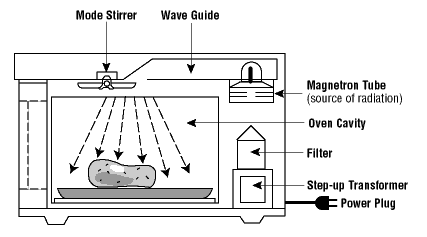Microwaves are very short waves of electromagnetic energy that travel at the speed of light (186,282 miles per second). Microwaves used in microwave ovens are in the same family of frequencies as the signals used in radio and television broadcasting.
The theory of electromagnetic energy can be illustrated by what happens when a pebble is tossed into a quiet pond. The pebble striking the still surface causes the water to move up and down in the form of ripples, or waves, that radiate in ever-widening circles over the surface of the pond. These waves, which move up and down at right angles to the direction they are traveling, are called transverse waves. Microwaves are examples of transverse waves. The disturbance resulting from the pebble landing in the water is transmitted through the water in the form of ripples or waves. The water serves merely as a medium through which the disturbance travels. In this sense, these ripples are more like sound waves, which also need a medium to travel through, normally using the molecules that exist in the air or water. That is why, for example, thundering rocket engines that would deafen the ears under normal circumstances, would be inaudible in the quiet vacuum of space. On the other hand, electromagnetic forms of energy, such as microwaves, radar waves, radio and TV waves, travel millions of miles through the emptiness of space without the need of any material medium through which to travel. This is because, simply put, electromagnetic waves are, in themselves, stored energy in motion.
Friday, August 31, 2012
Microwaves
3:55 PM
No comments
Electromagnetic radiation begins with a phenomenon that occurs when electric current flows through a conductor, such as a copper wire. The motion of the electrons through the wire produces a field of energy that surrounds the wire and floats just off its surface. This floating zone or cloud of energy is actually made up of two different fields of energy, one electric and one magnetic. The electric and magnetic waves that combine to form an electromagnetic wave travel at right angles to each other and to the direction of motion. If the current flowing through the wire is made to oscillate at a very rapid rate, the floating electromagnetic field will break free and be launched into space. Then, at the speed of light, the energy will radiate outward in a pulsating pattern, much like the waves in the pond. It is theorized that these waves are made up of tiny packets of radiant energy called photons. Streams of photons, each carrying energy and momentum, travel in waves like an undulating string of cars on a speeding roller coaster.
No. There is a very important difference. As illustrated by the frequency spectrum on the right, microwaves used in microwave ovens, similar to microwaves used in radar equipment, and telephone, television and radio communication, are in the non-ionizing range of electromagnetic radiation. Non-ionizing radiation is very different from Ionizing radiation . Ionizing radiation is extraordinarily high in frequency (millions of trillions of cycles per second). It is, therefore, extremely powerful and penetrating. Even at low levels, ionizing radiation can damage the cells of living tissue. In fact, these dangerous rays, have enough energy and intensity to actually change (ionize) the molecular structure of matter. In sufficient doses, ionizing radiation can even cause genetic mutations. As shown on the frequency spectrum, the ionizing range of frequencies includes X-rays, gamma rays, and cosmic rays. Ionizing radiation is the sort of radiation we associate with radioactive substances like uranium, radium, and the fall-out from atomic and thermonuclear explosions.
Non-ionizing radiation is very different. Because of the lower frequencies and reduced energy, it does not have the same damaging and cumulative properties as ionizing radiation. Microwave radiation (at 2450 MHz) is non-ionizing, and in sufficient intensity will simply cause the molecules in matter to vibrate, thereby causing friction, which produces the heat that cooks the food.
Source By
Subscribe to:
Post Comments (Atom)


















0 comments:
Post a Comment